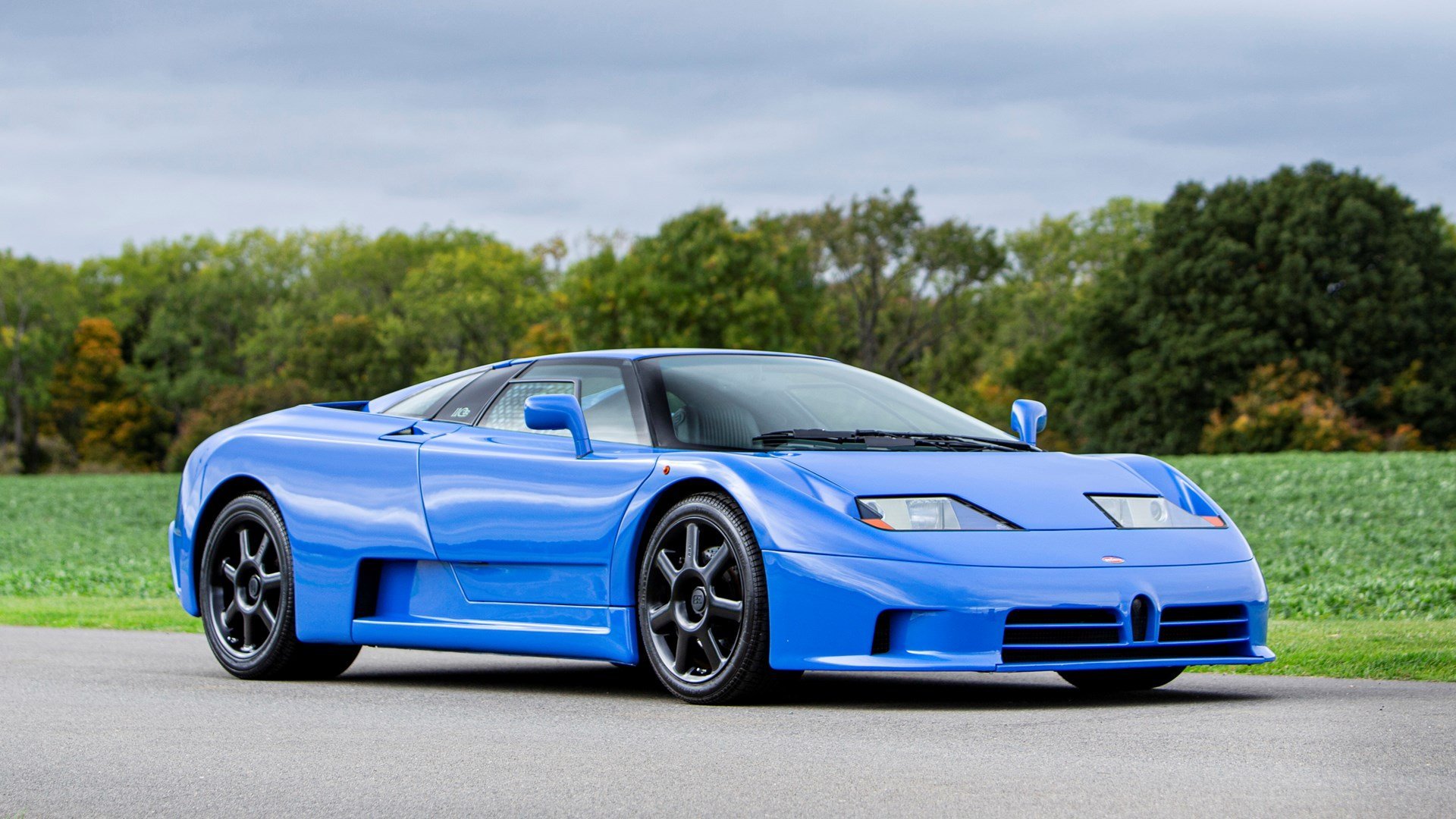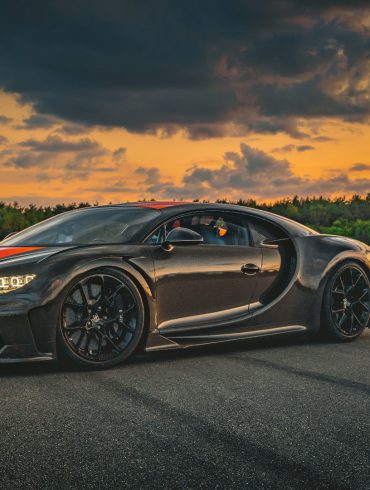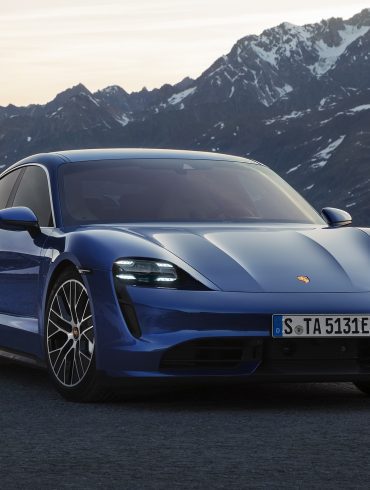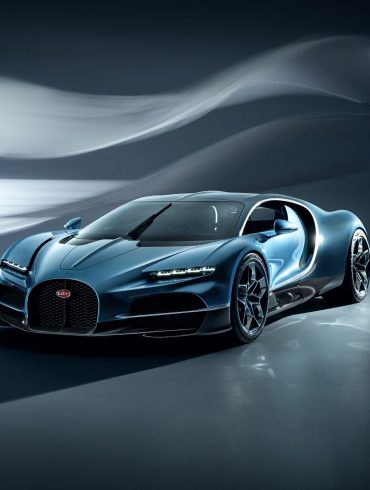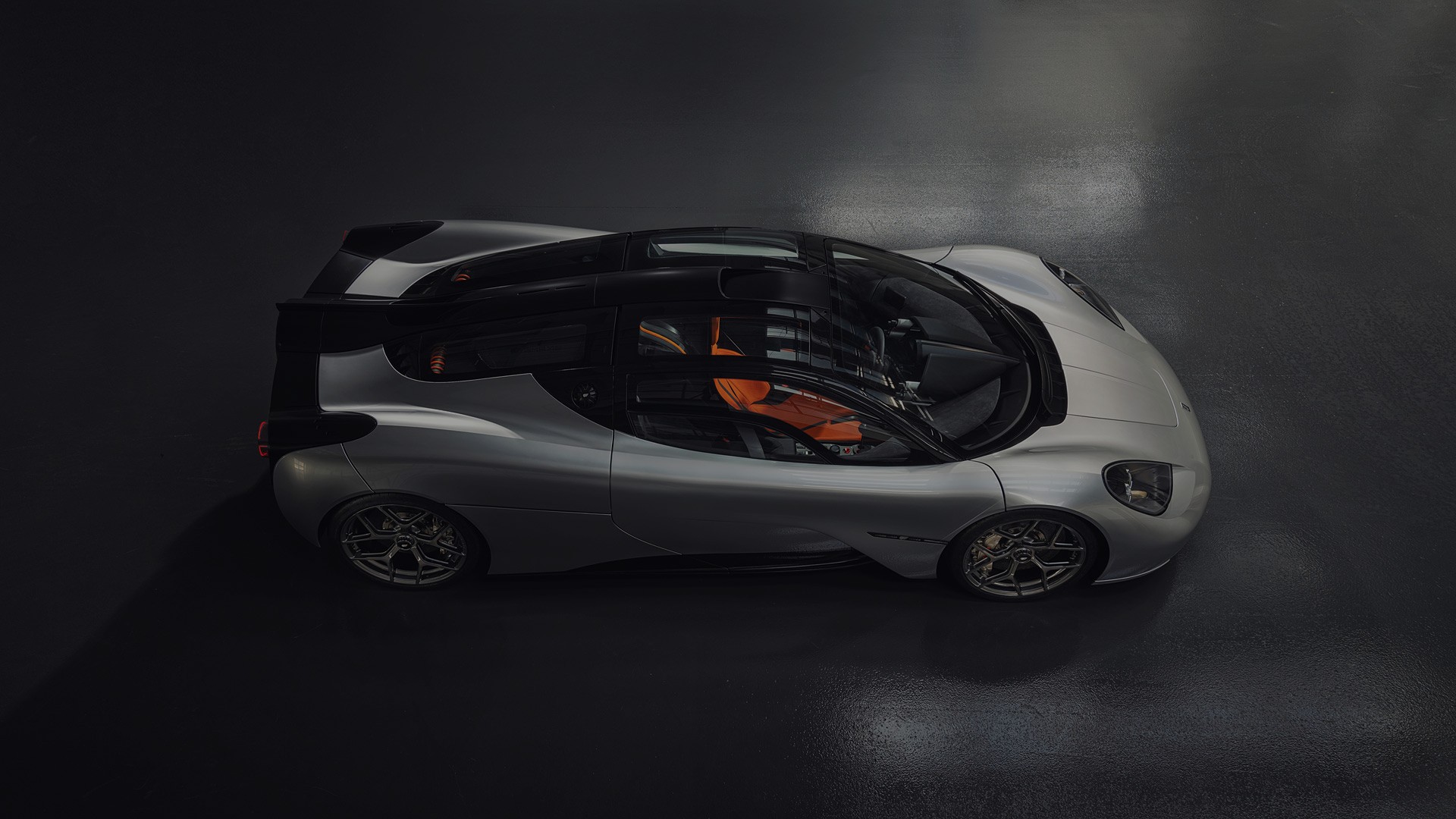1990s 0-60 & Quarter Mile Times
1990s Automotive Acceleration & Performance Data
Welcome to the ultimate guide to 0-60 mph and quarter mile times for 1990s cars! This page is your go-to resource for the most accurate, comprehensive, and easily accessible performance statistics of classic vehicles from the 1990s. Whether you're a supercar fan, or simply fascinated by this awesome era, our meticulously curated database offers unparalleled insights into the acceleration and speed of these timeless machines. Explore the remarkable performance of 1990s cars.
1990s Acceleration (0-60 mph & Quarter Mile Times)
1990s 0-60 mph and quarter-mile acceleration times. Narrow down your search via the filters.
You are trying to load a table of an unknown type. Probably you did not activate the addon which is required to use this table type.
The Fifteen Fastest Cars of the 1990s
The Quickest Cars of the 1990s Ranked
The 1990s were a remarkable decade for the automotive industry, characterized by significant advancements in engine technology, performance, and the emergence of iconic exotic supercars. This era saw a fusion of cutting-edge technology and innovative design, resulting in some of the most celebrated vehicles in automotive history.
In the United States, Chevrolet and Ford made notable strides in both performance and engineering. The Chevrolet Corvette continued to evolve, with the introduction of the C5 model in 1997. This generation featured a new LS1 V8 engine, offering enhanced power and efficiency, along with an improved suspension system for better handling. Ford, on the other hand, revitalized its Mustang lineup, culminating in the release of the high-performance SVT Cobra, which showcased the potential of the modular V8 engine and independent rear suspension, setting new standards for American muscle cars.
European manufacturers, particularly Ferrari, Aston Martin, and Jaguar, continued to push the boundaries of performance and luxury. Ferrari introduced some of its most iconic models, including the F355 and the revolutionary F50, which featured a Formula 1-derived V12 engine and cutting-edge aerodynamics. Aston Martin launched the DB7, a stunning blend of British elegance and powerful supercharged inline-six and V12 engines, revitalizing the brand's image. Jaguar, under the ownership of Ford, introduced the XK8, which combined classic Jaguar styling with modern technology and a new V8 engine, reinforcing its position in the luxury sports car market.
The 1990s were also a golden age for exotic supercars, with several groundbreaking models capturing the world's imagination. The McLaren F1, introduced in 1992, set new benchmarks for performance and design with its carbon-fiber construction, central driving position, and a BMW-sourced V12 engine that made it the fastest production car of its time. The Lamborghini Diablo, with its aggressive styling and powerful V12 engine, became an icon of 1990s excess and performance. Porsche continued to innovate with the 911 Turbo, which featured advanced all-wheel drive and turbocharging technology, maintaining its reputation for precision engineering and performance.
Japanese manufacturers also made significant contributions during this decade, with Toyota, Honda, and Nissan producing some of the most respected sports cars of the era. The Toyota Supra, with its turbocharged inline-six engine and advanced tuning potential, became a legend in both the street racing and tuning communities. Honda's NSX, co-developed with input from Formula 1 legend Ayrton Senna, offered supercar performance with the reliability and drivability of a Honda. Nissan's Skyline GT-R, featuring advanced all-wheel drive and twin-turbocharging technology, dominated the performance car scene and earned a cult following.
American brands like Chevrolet and Ford continued to innovate and improve their performance offerings. European manufacturers like Ferrari, Aston Martin, and Jaguar pushed the envelope of luxury and speed, while Japanese brands like Toyota, Honda, and Nissan cemented their reputations with legendary sports cars. The era's exotic supercars, exemplified by the McLaren F1 and Lamborghini Diablo, remain benchmarks for performance and design, marking the 1990s as a truly exceptional period in automotive history.
1. 1995 McLaren F1 LM
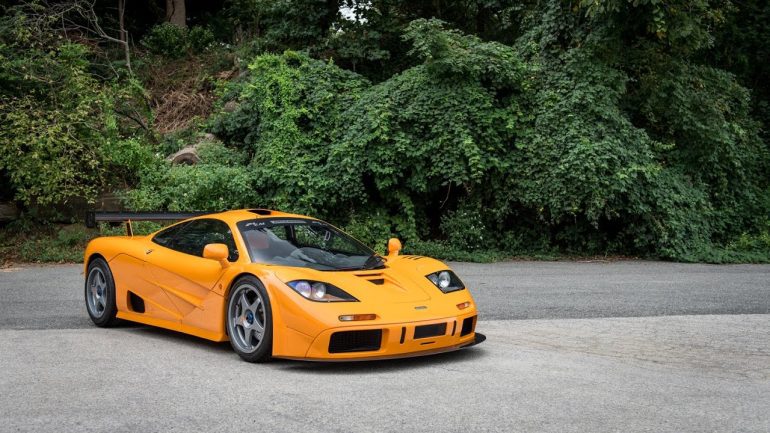
0 - 60: 2.9 seconds / Quarter Mile: N/A seconds
Summary
The 1995 McLaren F1 LM is a legendary supercar that solidified McLaren's dominance in the automotive world during the mid-1990s. Created as a tribute to the McLaren F1 GTR's Le Mans victory, this track-focused machine was a limited-production masterpiece, with only five examples ever built. It was designed to push the boundaries of performance and deliver an unparalleled driving experience on the circuit.
Underneath its aerodynamically optimized bodywork, the F1 LM housed a modified version of the BMW-sourced S70/2 6.1-liter V12 engine. Unlike the GTR's restricted engine, the LM's powerplant was unleashed, delivering an impressive 680 horsepower and 520 lb-ft of torque. This monstrous power, coupled with a six-speed manual transmission, propelled the F1 LM from 0 to 60 mph in just 2.9 seconds, reaching a top speed of 225 mph. Its acceleration was ferocious, and its handling was razor-sharp, thanks to its lightweight carbon fiber monocoque chassis, race-bred suspension, and massive downforce.
The F1 LM's performance wasn't just about raw power; it was a testament to McLaren's engineering expertise and relentless pursuit of perfection. Its active aerodynamics, including a fixed rear wing and a revised front splitter, generated significant downforce, improving stability and grip at high speeds. Its carbon-ceramic brakes provided exceptional stopping power, while its magnesium wheels and specially developed Michelin tires further enhanced its track capabilities. The F1 LM was a technological marvel, a true testament to McLaren's racing heritage, and a dream machine for those who craved the ultimate in driving thrills.
2. 1993 Bugatti EB110 SS
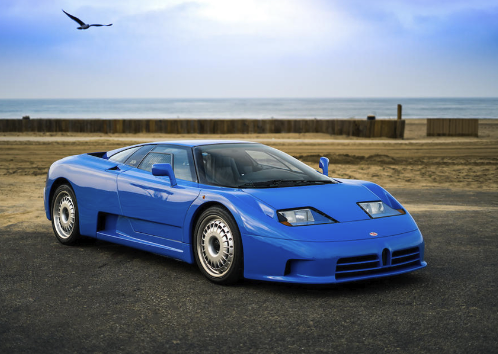
0 - 60: 3.1 seconds / Quarter Mile: 12.8 seconds
Summary
The 1993 Bugatti EB110 SS, short for Super Sport, was an extraordinary supercar that epitomized Bugatti's dedication to pushing automotive boundaries. As a more extreme version of the EB110 GT, the SS was designed to be lighter, faster, and more thrilling.
Beneath its aerodynamic bodywork, crafted from carbon fiber, the EB110 SS housed a 3.5-liter quad-turbocharged V12 engine, a technological marvel that produced a staggering 603 horsepower and 479 lb-ft of torque. This immense power, coupled with a six-speed manual transmission and all-wheel drive, propelled the EB110 SS from 0 to 60 mph in a blistering 3.1 seconds, with a top speed of 221 mph. These figures were groundbreaking for the time, cementing the EB110 SS as one of the fastest production cars in the world.
The EB110 SS wasn't just about straight-line speed. Its lightweight construction, advanced suspension, and all-wheel drive system provided exceptional handling and agility, making it a formidable machine on both the road and the track. Its aggressive styling, with its large rear wing and air intakes, further enhanced its performance and gave it a menacing presence.
While the EB110 SS's production run was short-lived due to Bugatti's financial difficulties, its impact on the automotive world was significant. It showcased the brand's commitment to innovation and set new benchmarks for performance that continue to inspire supercar manufacturers today. The EB110 SS remains a rare and highly sought-after collector's item, a testament to its groundbreaking performance and iconic status in automotive history.
3. 1991 Jaguar Sport XJR-15
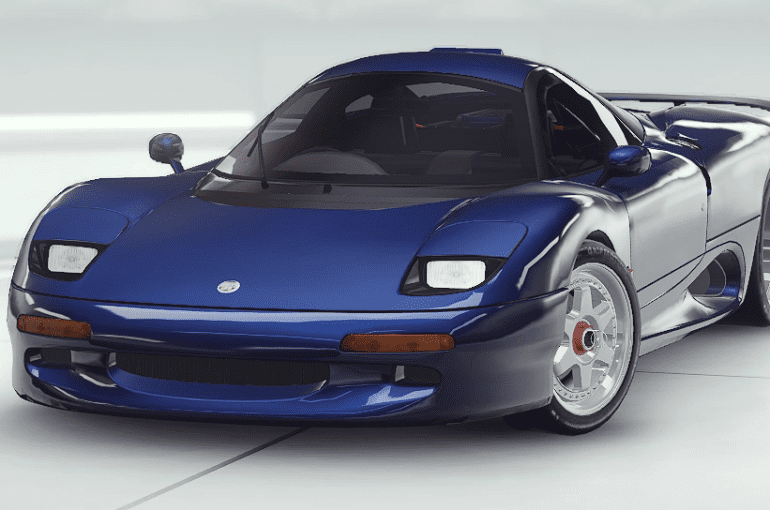
0 - 60: 3.2 seconds / Quarter Mile: N/A seconds
Summary
The 1991 Jaguar Sport XJR-15 is a legendary supercar that holds a special place in automotive history as the first road car built entirely of carbon fiber and Kevlar. Born from the successful Jaguar XJR-9 Group C race car, the XJR-15 was a homologation special designed to bring racing technology and performance to the road.
Under its aerodynamically sculpted body, the XJR-15 housed a 6.0-liter naturally aspirated V12 engine, a powerhouse that produced 450 horsepower and 420 lb-ft of torque. This engine, paired with an unsynchronized six-speed manual transmission, propelled the lightweight car from 0 to 60 mph in a blistering 3.2 seconds and on to a top speed of 191 mph. Its acceleration was brutal, and its handling was razor-sharp, thanks to its advanced suspension and race-bred chassis.
The XJR-15's performance wasn't just about raw power; it was a testament to Jaguar's engineering prowess and racing heritage. Its carbon-fiber construction not only reduced weight but also provided exceptional rigidity, contributing to its exceptional handling and agility. The car's limited production run of just 50 units, combined with its groundbreaking technology and impressive performance, made it a highly sought-after collector's item and a symbol of the pinnacle of automotive engineering in the early 1990s.
4. 1993 McLaren F1
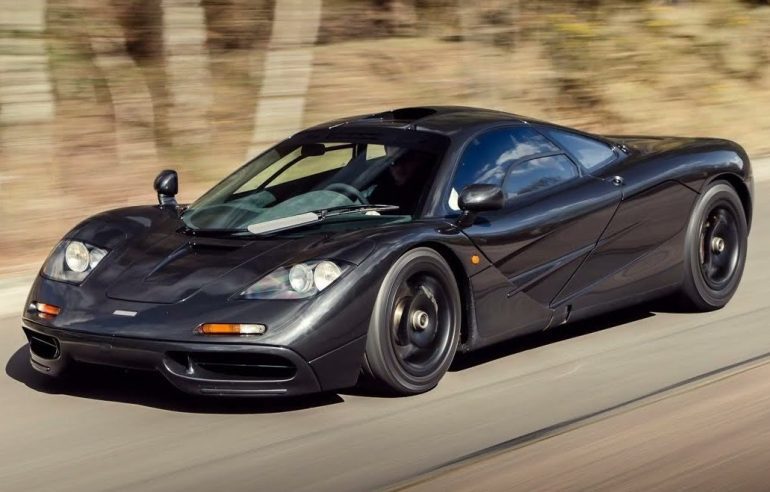
0 - 60: 3.2 seconds / Quarter Mile: 10.8 seconds
Summary
The 1993 McLaren F1 is a legendary supercar that redefined the boundaries of automotive engineering and performance. Designed by Gordon Murray, the F1 was a technological tour de force, showcasing groundbreaking innovations and a relentless pursuit of perfection.
At the heart of the F1 was a 6.1-liter naturally aspirated V12 engine, a masterpiece of engineering developed by BMW Motorsport. This powerful engine produced a staggering 627 horsepower and 480 lb-ft of torque, propelling the F1 from 0 to 60 mph in just 3.2 seconds. Even more impressive was its top speed, which was electronically limited to 240.1 mph, making it the fastest production car in the world at the time of its release.
But the F1's performance wasn't just about raw power. It was a meticulously engineered machine designed to deliver an unparalleled driving experience. Its carbon fiber monocoque chassis, active aerodynamics, and central driving position all contributed to its exceptional handling and agility. The car's lightweight construction and near-perfect weight distribution further enhanced its performance, making it a joy to drive on both the road and the track.
The 1993 McLaren F1 is more than just a supercar; it's an icon, a symbol of automotive excellence and a testament to McLaren's engineering prowess. Its revolutionary design, groundbreaking technology, and exceptional performance have cemented its place in automotive history as one of the greatest cars ever created.
5. 1999 Mercedes-Benz CLK GTR
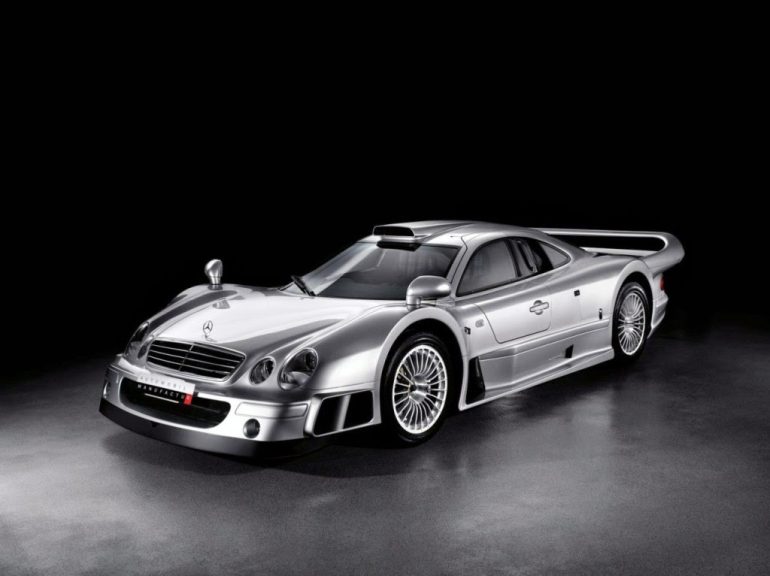
0 - 60: 3.3 seconds / Quarter Mile: 9.3 seconds
Summary
The 1999 Mercedes-Benz CLK GTR is a legendary homologation special that solidified the brand's dominance in the FIA GT Championship during the late 1990s. While primarily designed as a race car, Mercedes-Benz was obligated to produce a limited number of road-legal versions to comply with racing regulations, resulting in one of the most exclusive and sought-after supercars ever created.
Underneath its aggressive, aerodynamic bodywork, the CLK GTR housed a 6.9-liter V12 engine, a powerhouse that produced just over 600 horsepower in street-legal form. This allowed the car to achieve incredible performance figures, with a 0-60 mph time of 3.3 seconds and a top speed close to 200 mph. Its acceleration was brutal, and its handling was razor-sharp, thanks to its advanced suspension system and race-bred chassis.
The CLK GTR's performance wasn't just about raw power; it was a testament to Mercedes-Benz's engineering expertise and commitment to racing excellence. Its carbon fiber monocoque chassis, sequential gearbox, and aerodynamic design were all derived from the race car, providing exceptional rigidity, responsiveness, and downforce. The car's limited production run of just 25 units, combined with its groundbreaking performance and racing pedigree, made it a highly coveted collector's item and a symbol of the pinnacle of automotive engineering in the late 1990s.
6. 1997 Ferrari F50

0 - 60: 3.5 seconds / Quarter Mile: 11.9 seconds
Summary
The 1997 Ferrari F50 was a limited-production supercar that celebrated Ferrari's 50th anniversary in spectacular fashion. Designed as a road-going version of a Formula 1 car, the F50 was a technological marvel that pushed the boundaries of performance and engineering.
At its heart was a naturally aspirated 4.7-liter V12 engine, a direct descendant of the powerplant used in the 1990 Ferrari 641 Formula One car. This screaming V12, mounted directly to the carbon fiber chassis, produced 513 horsepower and 347 lb-ft of torque. With a six-speed manual transmission and rear-wheel drive, the F50 could launch from 0 to 60 mph in a mere 3.5 seconds, reaching a top speed of 202 mph. Its acceleration was brutal, its handling razor-sharp, and its sound was pure symphony.
The F50's performance wasn't just about raw power. It was a meticulously engineered machine with a lightweight carbon fiber monocoque chassis, pushrod suspension, and Brembo brakes. Its aerodynamic design, featuring a prominent rear wing and integrated spoilers, ensured maximum downforce and stability at high speeds.
Inside the cockpit, the F50 was a minimalist's dream, with a focus on functionality and driver engagement. Its carbon fiber seats, spartan dashboard, and gated shifter provided an unfiltered connection between driver and machine. The F50 was a true driver's car, a masterpiece of engineering that combined raw power with precision handling and an unforgettable driving experience.
7. 1999 Lamborghini Diablo GT
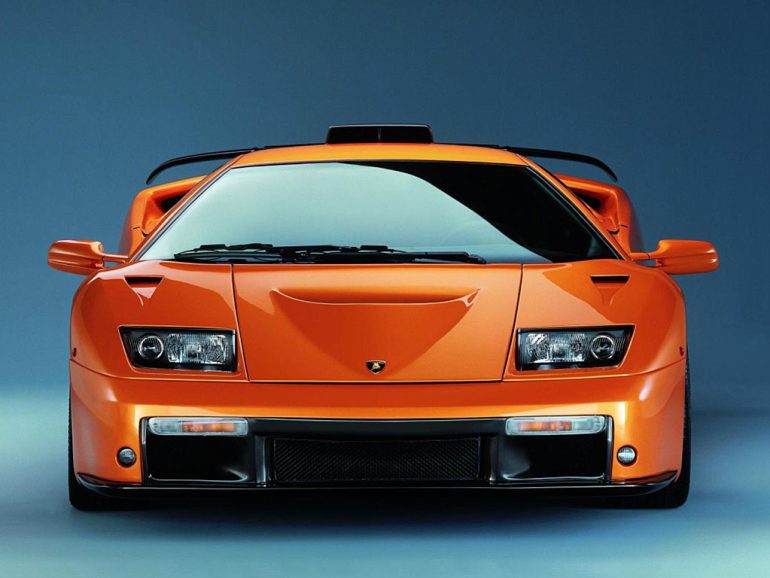
0 - 60: 3.6 seconds / Quarter Mile: 12.0 seconds
Summary
In 1999, Lamborghini fans got a pleasant surprise when the Diablo GT was revealed at the Geneva Motor Show. It combined the modifications of the GT2 race car with the outrageousness of the Diablo to offer serious road racing performance. So much so, it remains as the fastest road-going Diablo ever made by the factory. At the time of delivery in September 1999, the Diablo GT was also one of the fastest supercars as well, reaching a top speed of 215 mph (346 kph).
What set the GT apart from the Diablos before it was a comprehensive list of upgrades which included a larger V12 engine and a radical carbon fibre body. This meant the GT was lighter, faster and had better road-handling than all other Diablos. Much of the GT’s diet can be attributed to its extensive use of composite materials including bodywork fabricated almost completely of carbon fibre. The only non-composite panels were the steel roof and aluminum doors.
Particularly distinct was the front bodywork which accommodated a wider track, brake cooling ducts and a front-mounted oil cooler. Air entered the oil cooler from the very front of the car and exited via an extractor atop the bonnet. A large engine scoop also sat atop the engine cover feeding the V12 with fresh air. Unlike the SV, airflow for this scoop was dynamically controlled by the on-board computer. Only 80 examples of the GT were constructed, each in either orange, titan-silver, black or yellow bodywork. Depending on the customer’s use, each came with custom ratios, the longest of which offered a top speed of 215 mph.
8. 1997 Porsche 911 Turbo S (993)
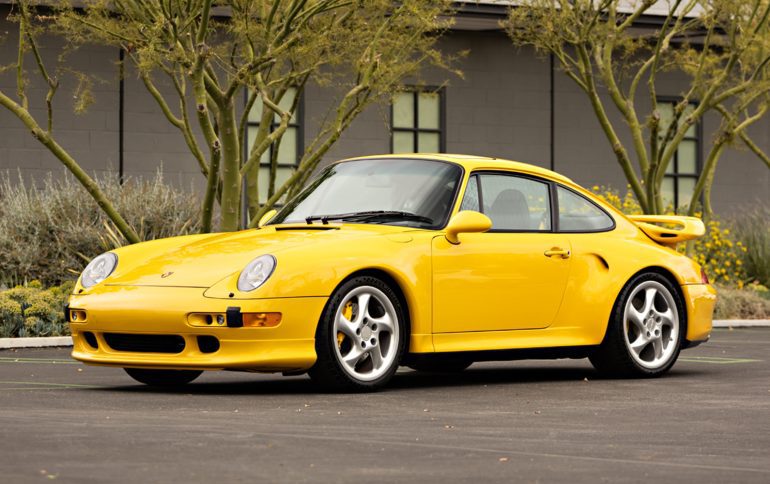
0 - 60: 3.6 seconds / Quarter Mile: 12.0 seconds
Summary
The 1997 Porsche 911 Turbo S (993) is a legendary and highly sought-after sports car that represents the pinnacle of the air-cooled era for the 911 lineage. As the most powerful and exclusive variant of the 993 generation, it holds a special place in the hearts of Porsche enthusiasts and collectors alike.
Under its iconic silhouette, the 911 Turbo S (993) boasted a twin-turbocharged 3.6-liter flat-six engine, meticulously tuned to produce an impressive 424 horsepower and 420 lb-ft of torque for the US market. This robust powerplant, combined with all-wheel drive and a six-speed manual transmission, propelled the car from 0 to 60 mph in a mere 3.6 seconds, a remarkable feat for its time. Its top speed of 184 mph further solidified its status as a true performance machine.
The 911 Turbo S (993) wasn't just about raw power; it also featured a revised suspension with stiffer springs and dampers, a limited-slip differential, and larger brakes, all of which contributed to its exceptional handling and agility. Its widebody design and "whale tail" spoiler not only added to its aggressive appearance but also improved its aerodynamics and stability at high speeds.
Inside, the Turbo S (993) offered a luxurious and driver-focused cabin with supple leather upholstery, carbon fiber trim, and a host of high-tech features for its time. Its limited production run of just 345 units worldwide, combined with its iconic status and exceptional performance, has made the 1997 Porsche 911 Turbo S (993) a highly desirable and valuable collector's car.
9. 1992 Ferrari F40
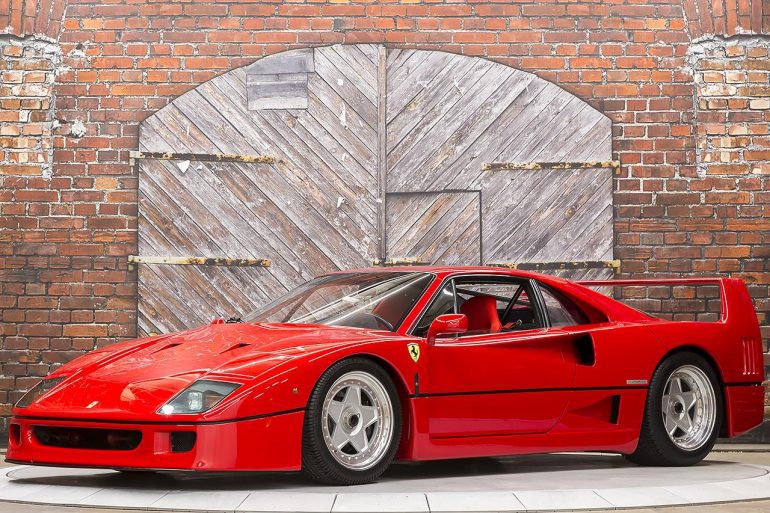
0 - 60: 3.7 seconds / Quarter Mile: 11.7 seconds
Summary
The 1992 Ferrari F40 was a raw and uncompromising supercar that represented the pinnacle of Ferrari's performance capabilities in the early 1990s. It was the last car personally approved by Enzo Ferrari before his passing, and it was designed to be a no-holds-barred machine that paid homage to the brand's racing heritage.
Under its iconic Pininfarina-designed bodywork, the F40 housed a twin-turbocharged 2.9-liter V8 engine, a technological marvel that produced 478 horsepower and 426 lb-ft of torque. This power, channeled through a five-speed manual transmission, propelled the lightweight F40 from 0 to 60 mph in 3.7 seconds. Its top speed of 201 mph made it the fastest production car in the world at the time of its release.
The F40's performance wasn't just about straight-line speed. Its tubular steel chassis, lightweight composite body panels, and race-inspired suspension contributed to its exceptional handling and agility. However, its raw and unfiltered driving experience demanded respect and skill from the driver, making it a challenging but rewarding car to master.
The F40's spartan interior, devoid of luxury amenities, reflected its focus on performance. It was a car built for driving enthusiasts who craved a visceral and unadulterated experience behind the wheel. The 1992 Ferrari F40 remains a legend in the automotive world, a testament to Ferrari's engineering prowess and a reminder of a time when supercars were raw, uncompromising machines.
10. 1993 Jaguar XJ220
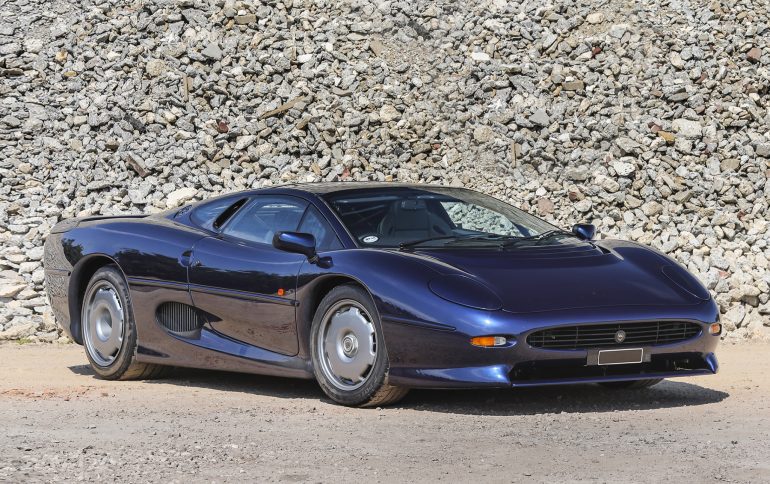
0 - 60: 3.7 seconds / Quarter Mile: 11.9 seconds
Summary
The 1993 Jaguar XJ220 was a groundbreaking supercar that pushed the boundaries of automotive engineering and design. Conceived in the late 1980s, it captured the world's attention with its sleek, futuristic styling and promises of blistering performance. While it faced challenges during its development and launch, the XJ220 remains an iconic symbol of Jaguar's ambition and innovation.
Under its aerodynamic bodywork, the XJ220 originally envisioned a V12 engine, but production models received a twin-turbocharged 3.5-liter V6 engine. This powerplant, developed in conjunction with Tom Walkinshaw Racing, produced a remarkable 542 horsepower and 475 lb-ft of torque. With its lightweight aluminum chassis and advanced aerodynamics, the XJ220 could sprint from 0 to 60 mph in 3.7 seconds and reach a top speed of 212 mph, making it one of the fastest production cars of its era.
The XJ220's performance wasn't just about straight-line speed. Its racing-derived suspension and all-wheel-drive system provided exceptional handling and grip, allowing it to conquer corners with confidence. However, its large size and heavy steering could make it a challenging car to drive at the limit. Despite its flaws, the XJ220 remains a legend in the automotive world, a testament to Jaguar's engineering prowess and a reminder of a time when supercars were truly pushing the boundaries of performance.
11. 1999 Pagani Zonda C12-S
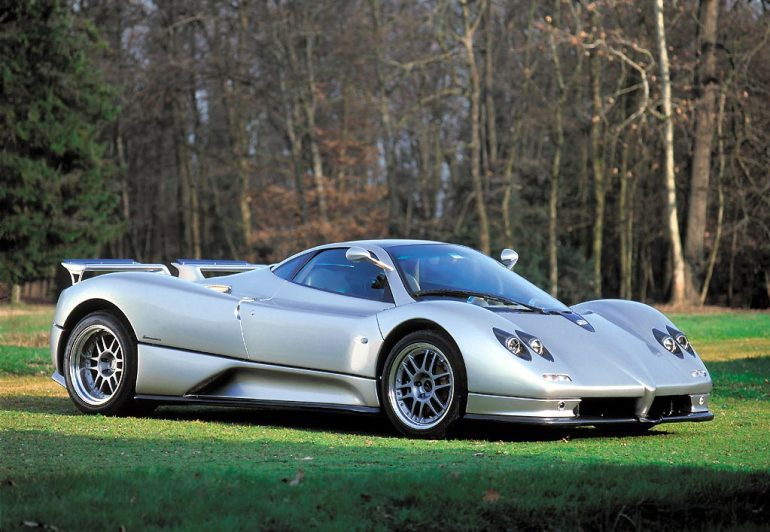
0 - 60: 3.7 seconds / Quarter Mile: 11.9 seconds
Summary
The 1999 Pagani Zonda C12-S is a legendary supercar that solidified Pagani's place among the elite automotive manufacturers. As an evolution of the original Zonda C12, the C12-S brought significant improvements in both performance and aesthetics, making it a coveted collector's item and a dream machine for enthusiasts.
Under its breathtakingly sculpted carbon fiber body, the Zonda C12-S housed a 7.0-liter AMG-sourced V12 engine. This naturally aspirated powerhouse produced 550 horsepower and 553 lb-ft of torque, propelling the car from 0 to 60 mph in 3.7 seconds. Its top speed of 220 mph (354 km/h) was equally impressive, showcasing the car's incredible performance capabilities.
The C12-S wasn't just about straight-line speed. Its lightweight construction, advanced suspension system, and aerodynamic design made it a formidable machine on the track. Its precise handling, responsive steering, and powerful brakes allowed it to carve through corners with confidence, delivering a truly exhilarating driving experience.
Inside, the C12-S was a symphony of craftsmanship and luxury. The interior featured bespoke materials like leather, carbon fiber, and aluminum, meticulously crafted to create a unique and elegant ambiance. The car's distinctive design, combined with its exceptional performance and luxurious interior, made it a true masterpiece of automotive engineering and artistry.
12. 1996 Porsche 911 GT1 Straßenversion
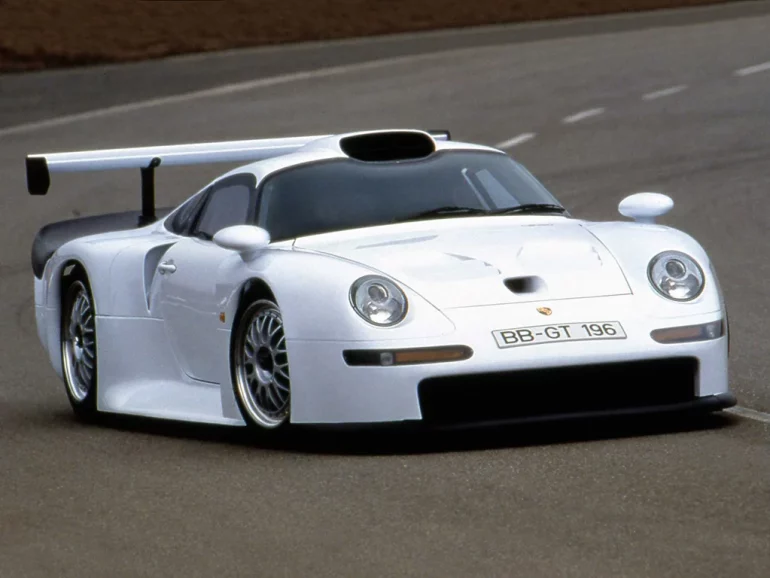
0 - 60: 3.7 seconds / Quarter Mile: N/A seconds
Summary
The 1996 Porsche 911 GT1 Straßenversion, often simply referred to as the GT1 Street Version, was a rare and exceptional supercar that blurred the lines between a race car and a road car. Created as a homologation special for the FIA GT Championship, only two examples of this road-legal version were ever built, making it a highly sought-after collector's item.
Underneath its aggressive, aerodynamic bodywork, which bore a striking resemblance to its racing counterpart, the GT1 Straßenversion housed a twin-turbocharged 3.2-liter flat-six engine, a slightly detuned version of the engine used in the GT1 race car. This potent powerplant produced 544 horsepower and 443 lb-ft of torque, propelling the car from 0 to 60 mph in a blistering 3.7 seconds. Its top speed was reported to be 191 mph, a testament to its incredible performance capabilities.
While the GT1 Straßenversion shared many components with the race car, it was still designed to be road legal, featuring a slightly raised ride height, a more comfortable interior, and a few additional amenities. However, its focus remained on performance, with a lightweight carbon-fiber chassis, a sequential gearbox, and a track-tuned suspension. The GT1 Straßenversion was a raw and visceral machine that offered an unparalleled driving experience, combining the thrill of a race car with the exclusivity of a limited-edition supercar. It remains a testament to Porsche's engineering prowess and its commitment to pushing the boundaries of performance.
13. 1998 Porsche 911 GT2 (993)

0 - 60: 3.7 seconds / Quarter Mile: 12.1 seconds
Summary
The 1998 Porsche 911 GT2 (993) is a legendary and exhilarating sports car that cemented its place in Porsche's history as a raw, track-focused machine. As the most powerful and rare 911 variant of its time, it attracted a cult following among driving enthusiasts who craved a pure and unfiltered driving experience.
Underneath its widebody stance and iconic "whale tail" rear spoiler, the 911 GT2 (993) housed a twin-turbocharged 3.6-liter flat-six engine, a technological marvel that produced a staggering 450 horsepower and 432 lb-ft of torque. This power, channeled solely through the rear wheels and a six-speed manual transmission, propelled the GT2 from 0 to 60 mph in just 3.7 seconds, with a top speed of 187 mph. Its raw acceleration and high-revving engine were a testament to Porsche's engineering prowess and commitment to performance.
The GT2's performance wasn't just about straight-line speed. It was also a track-ready weapon, thanks to its sport-tuned suspension, large brakes, and lightweight construction. The car's rear-wheel drive layout and lack of electronic aids demanded respect and skill from the driver, but for those who could tame it, it offered a rewarding and visceral driving experience. Its responsive steering and communicative chassis provided a direct connection to the road, making it a joy to drive on both the street and the track.
The 1998 Porsche 911 GT2 (993) remains a highly sought-after collector's car, cherished by enthusiasts for its raw power, unfiltered driving experience, and iconic status. Its legacy lives on as a reminder of Porsche's dedication to building performance-focused machines that push the boundaries of what's possible.
14. 1997 Dodge Viper GTS
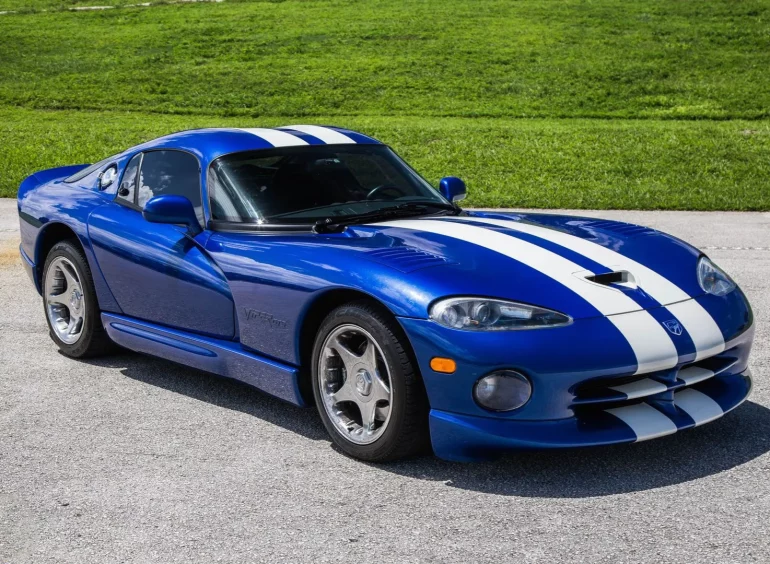
0 - 60: 4.0 seconds / Quarter Mile: 12.2 seconds
Summary
The 1997 Dodge Viper GTS was a visceral and exhilarating American supercar that cemented its place in automotive history with its raw power and iconic design. It was the coupe version of the already infamous Viper RT/10 Roadster, offering a more refined driving experience with the addition of a roof, roll-up windows, and air conditioning, without sacrificing any of the Viper's performance credentials.
Underneath its muscular bodywork, the Viper GTS housed an 8.0-liter V10 engine, a behemoth of a powerplant that produced 450 horsepower and 490 lb-ft of torque. This massive engine, paired with a six-speed manual transmission, propelled the Viper GTS from 0 to 60 mph in around 4.0 seconds, with a quarter-mile time of 12.2 seconds. Its top speed was electronically limited to 185 mph, but it was capable of much more.
The Viper GTS wasn't just about straight-line speed. It also boasted impressive handling capabilities for its time, thanks to its revised suspension and sticky tires. While its ride was firm and unforgiving, it provided a direct and engaging driving experience that was praised by enthusiasts and critics alike. Its powerful brakes ensured confident stopping power, while its aerodynamic design helped it remain stable at high speeds.
The 1997 Dodge Viper GTS was a raw and visceral machine that offered an unparalleled driving experience. Its iconic design, monstrous engine, and impressive performance figures made it a true American supercar that could hold its own against the world's best.
15. 1996 Lamborghini Diablo SV
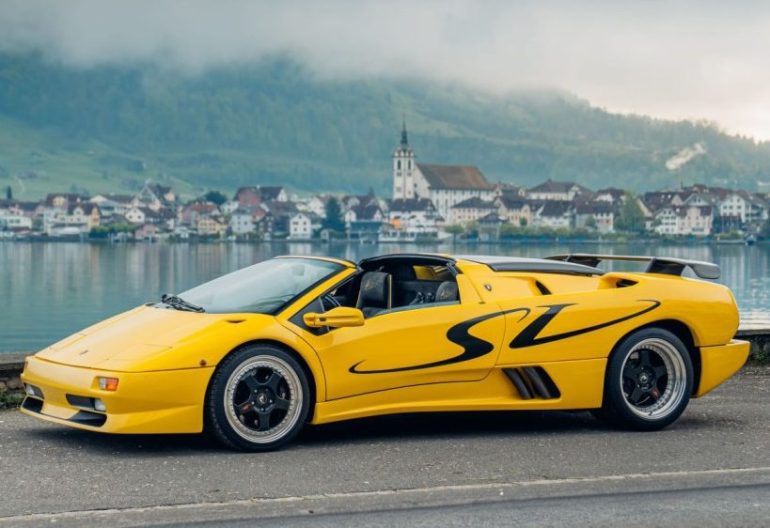
0 - 60: 3.8 seconds / Quarter Mile: N/A seconds
Summary
The Lamborghini Diablo SV, first introduced in 1999, was a raw and visceral supercar that embodied the brand's commitment to unadulterated performance and aggressive design. It was a stripped-down, back-to-basics version of the iconic Diablo, with a focus on weight reduction and enhanced driving dynamics.
Underneath its angular bodywork, the Diablo SV housed a 5.7-liter V12 engine, a naturally aspirated powerhouse that produced 510 horsepower and 428 lb-ft of torque in its initial release. This power, channeled through a five-speed manual transmission and rear-wheel drive, propelled the Diablo SV from 0 to 60 mph in 3.8 seconds, with a top speed of 202 mph. In later years, the engine received a slight power boost, reaching 530 horsepower in 1999.
The Diablo SV wasn't just about straight-line speed. It also featured a revised suspension, larger brakes, and a fixed rear wing for improved downforce and handling. Its aggressive styling, with its massive air intakes, fixed headlights, and optional SV wing, further emphasized its track-focused nature. While its handling could be challenging due to its powerful rear-wheel-drive setup, the Diablo SV was a thrilling and visceral car to drive, delivering an unforgettable experience for those who dared to tame it.
The Diablo SV was a special car in Lamborghini's history, representing a return to the brand's roots of building raw and uncompromising supercars. Its raw power, aggressive design, and exhilarating performance solidified its status as a legend in the automotive world.


